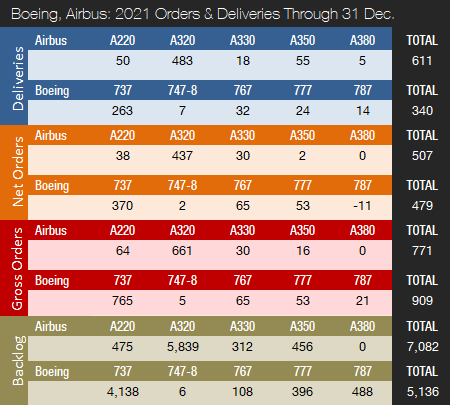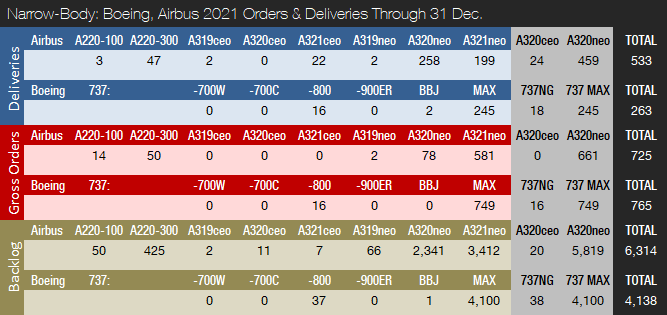

Boeing and Airbus delivered 99 and 187 commercial jets in the fourth quarter of 2021, compared to 59 and 225 deliveries, respectively, in Q4 2020. Q4 marked another quarter of strong year-over-year growth for Boeing, whereas Airbus delivered fewer aircraft than in the fourth quarter of 2020 due to a dip in October shipments.
Following a more than challenging 2020 due to the COVID-19 pandemic, 2021 was a year of recovery for the two largest commercial plane makers. However, Boeing and Airbus still have quite a way to go before deliveries are back to pre-pandemic levels. For the full year 2021, Boeing delivered 340 aircraft, compared to 157 and 380 in 2020 and 2019, respectively. Boeing’s last “normal” year was 2018 – before COVID and the 737 MAX grounding – when it delivered 806 jets, a level that will likely not be recaptured before 2024 or 2025. The past three years have been extremely challenging for Boeing but, despite ongoing Dreamliner issues, things are now looking brighter than at any time since the second 737 MAX crash occurred in March 2019. Orders are strong and deliveries have surged from the 2020 lows, with another sharp increase expected in 2022. In addition, the 737 MAX is poised to resume commercial flights in China any day now – well over a year after the FAA ungrounded the aircraft in November 2020.
In 2021, Airbus delivered 611 aircraft and won the deliveries crown for the third year in a row. Deliveries were up from 566 in 2020 but remain well below the company’s all-time record high of 863 shipments in 2019. Airbus is expected to retain the deliveries lead for the foreseeable future due to the company’s comfortable backlog lead over its American rival. Prior to 2019, Boeing had out-delivered Airbus every year since 2012.
As indicated above, in Q4 2021, Boeing delivered 99 jets – up from 85 in Q3 – including 84 737s (78 MAX / 6 NG), three 747-8s, eight 767s, and four 777s. Boeing expects to increase the 737 MAX production rate to 31 per month by early 2022, up from 19 by the end of October 2021. Further increases will follow as market demand allows. No 787s were delivered in the fourth quarter after Boeing halted deliveries in May 2021 for the second time in less than a year. The U.S. Federal Aviation Administration (FAA) is reviewing Boeing’s method for inspecting and evaluating the aircraft to ensure it meets federal safety regulations. The FAA is also looking into whether modifications are needed on in-service 787s; however, the regulator has also made it clear that the issue poses no immediate threat to flight safety. Recently, new manufacturing defects were identified and the FAA has issued a number of memos and warnings. According to Boeing, the company is continuing to complete comprehensive inspections across the 787 production system and within the supply chain, while holding detailed, transparent discussions with the FAA, suppliers, and customers. In November, leaders of the U.S. House Transportation and Infrastructure Committee asked for a government review of the FAA’s oversight of the 787. The current 787 production rate is approximately two aircraft per month and Boeing expects to continue at this rate until deliveries resume and then return to five per month over time. It is currently unknown when deliveries will be allowed to continue. The 777 program will get a new addition in late 2023 with the first delivery of the 777X. Meanwhile, talks continue on a 777X freighter variant to replace the 777F.
In Q4 2021, Airbus delivered 187 jets – up from 127 in Q3 – including 16 A220s, 142 A320s (138 NEO / 4 CEO), seven A330s, 19 A350s, and three A380s. During 2021, Airbus steadily increased A320 production from 40 per month to 43 in Q3 2021 before finishing the year at a rate of 45. Production will be gradually increased until reaching a monthly rate of 65 by summer 2023. Airbus has also discussed a scenario with a rate of 70 by Q1 2024. Longer term, the company is investigating opportunities for rates as high as 75 by 2025. The A220, meanwhile, is being produced at a rate of five aircraft per month. The rate will be increased to six in early 2022 – with a monthly production rate of 14 envisioned by the middle of the decade. The A350 production rate currently averages five per month and will be increased to six by early 2023. Airbus is currently producing two A330s per month, a rate that will be increased to nearly three aircraft by the end of 2022. In 2021, Airbus launched the new A350 freighter, or A350F, which is a major and much-needed boost to the company’s competitiveness in the cargo segment. Boeing has long dominated the cargo space with its 737-800BCF, 767-300BCF, 767-300F, 777F and 747-8F offerings. Until now, Airbus has only offered the A330-200F, which has not performed well in competition against Boeing’s popular 767-300F. With the launch of the A350F, it appears Airbus is finally getting serious about capturing more of the cargo aircraft market. The A350F, which carries up to 120 tons (109 metric tons) of cargo, received its first order in November and will predominantly compete with the 777F. In comparison, the 777F has a cargo capacity of up to 112 tons (102 metric tons). On December 16, Airbus delivered the 251st and final A380 to Emirates. The A380 is an impressive feat of aeronautical engineering and will, despite its lack of financial success, be forever enshrined in the annals of aviation history. With 123 A380s purchased, Emirates took delivery of nearly half the A380 fleet and currently operates 121 of the superjumbos.
Turning to the Q4 2021 orders review, a number of major orders were announced at the 2021 Dubai Airshow in November, which ended with over 500 new aircraft sales – a clear signal that the commercial aviation sector is recovering from the pandemic. Boeing had a solid fourth quarter and booked nine orders for a total of 199 jets. However, the company also reported 22 cancellations, of which 20 were for the 737 MAX, resulting in 177 net new orders in total. The 199 gross orders included 174 737s (all MAX), 19 767s, and six 777s. The largest order was placed by Akasa Air, which ordered 72 737 MAX jets at the 2021 Dubai Airshow. The order was a mix of regular 737-8s and high-capacity 737-8-200s. Akasa Air is an upcoming Indian low-cost airline expected to commence operations in May 2022. Also in Q4, Allegiant Air ordered 50 737 MAXs (a mix of 737-7s and 737-8-200s), ahead of 777 Partners, which booked 30 737 MAX jets. Furthermore, UPS ordered 19 767-300Fs for delivery between 2023 and 2025. In 2021, Boeing booked an impressive 909 gross orders and received 430 cancellations, for a total of 479 net new orders (before ASC 606 changes). In 2020, Boeing accumulated a total of 184 gross orders and received 655 cancellations, for a total of -471 net new orders.

Airbus had a very strong fourth quarter in 2021 and was the clear winner at the Dubai Airshow. The company booked 18 orders during the quarter for a total of 501 jets. Airbus also reported 127 cancellations, resulting in 374 net new orders. The largest order was placed by Air Lease Corporation (ALC), a leading American aircraft leasing company based in Los Angeles. ALC’s order includes 79 A321neos (a mix of regular A321neos and A321XLRs), 25 A220-300s, five A330-900s, and seven A350 freighters, for a total of 116 aircraft. Also in Q4, Wizz Air, a Hungarian ultra-low-cost carrier, ordered 102 A321neos. The order comprises 75 regular A321neos and 27 A321XLRs, with the bulk to be delivered between 2025 and 2027. Furthermore, Frontier Airlines ordered 91 A321neos.
In 2021, Airbus booked a total of 771 gross orders and received 264 cancellations, for a total of 507 net new orders – enough to win the orders crown for the third year in a row. It should be noted, however, that if Boeing’s 2021 ASC 606 adjustments are included, Boeing comes out ahead with 535 net new orders. In 2020, Airbus accumulated 383 gross orders and received 115 cancellations, for a total of 268 net new orders.
At the end of December 2021, Airbus reported a backlog of 7,082 jets, of which 6,314, or 89 percent, were A220 and A320ceo/neo family narrowbodies. This is 643 aircraft below the company’s all-time backlog record of 7,725 aircraft set in January 2020. By the end of the year, Boeing’s backlog (total unfilled orders before ASC 606 adjustment) was 5,136 aircraft, of which 4,138, or 81 percent, were 737 NG/MAX narrowbody jets. Boeing’s all-time backlog high of 5,964 aircraft was set in August 2018. The number of Airbus aircraft to be built and delivered represents 8.2 years of shipments at the 2019 production level (the pre-pandemic level), or 11.6 years based on the 2021 total. In comparison, Boeing’s backlog would “only” last 6.4 years at the 2018 level (the most recent “normal” year for Boeing), or 15.1 years based on 2021 deliveries. In 2021, Boeing’s book-to-bill ratio, calculated as net new orders divided by deliveries, is 1.41, ahead of Airbus’ book-to-bill ratio of 0.83. In 2020, Boeing’s book-to-bill ratio was negative, while Airbus reported a book-to-bill of 0.47.
2022 Forecast
Forecast International’s Platinum Forecast System is a breakthrough in forecasting technology that provides 15-year production forecasts. The author has used the Platinum Forecast System to retrieve the latest delivery forecast data from the Civil Aircraft Forecast product. For2022, Forecast International’s analysts currently expect Boeing and Airbus to deliver 483 and 694 commercial jets, respectively. Compared to the 2021 level, this is a 42.1 percent increase for Boeing and a 22.6 percent increase for Airbus.
On January 26, Boeing will report Q4 and full-year 2021 earnings and operating results, followed by Airbus on February 17. As most of the uncertainty in the marketplace appears to be subsiding, both companies can be expected to provide some form of guidance on planned 2022 deliveries.





References:
- https://www.forecastinternational.com/platinum.cfm
- http://www.boeing.com/commercial/#/orders-deliveries
- https://www.airbus.com/aircraft/market/orders-deliveries.html
- https://boeing.mediaroom.com/2021-10-27-Boeing-Reports-Third-Quarter-Results
- https://boeing.mediaroom.com/2021-11-16-Akasa-Air-Orders-72-Fuel-Efficient-737-MAX-Airplanes-to-Launch-Service-in-Fast-Growing-Indian-Market
- https://boeing.mediaroom.com/2022-01-05-Allegiant-Air-Orders-Up-to-100-737-MAX-Jets
- https://www.bloomberg.com/news/articles/2022-01-13/boeing-s-737-max-nears-return-to-commercial-service-in-china
- https://www.cnbc.com/2021/11/20/us-house-panel-seeks-review-of-faa-oversight-of-boeing-787.html
- https://www.boeing.com/commercial/freighters/
- https://www.airbus.com/en/newsroom/press-releases/2021-10-airbus-reports-nine-month-9m-2021-results
- https://www.airbus.com/en/newsroom/press-releases/2022-01-airbus-achieves-2021-commercial-aircraft-delivery-target
- https://newsnreleases.com/2021/11/15/wizz-air-to-purchase-102-airbus-a321-aircraft/
- https://www.airbus.com/en/newsroom/press-releases/2021-11-alc-order-for-111-airbus-aircraft-launches-sustainability-fund
- https://airinsight.com/dubai-airshow-2021-ends-with-509-new-aircraft-sales/
- https://airwaysmag.com/industry/2021-dubai-airbus-boeing/
- https://www.globenewswire.com/news-release/2021/11/14/2333729/30034/en/Frontier-Airlines-Orders-91-Additional-A321neo-Aircraft-Tripling-Size-by-2029.html
- https://www.airbus.com/en/newsroom/press-releases/2021-11-408-aircraft-including-the-first-a350f-ordered-at-the-dubai-airshow
- https://edition.cnn.com/travel/article/last-a380-emirates/index.html
- https://www.airbus.com/en/newsroom/stories/2021-12-the-a380-emirates-and-flying-public-a-winning-combination
- https://aircraft.airbus.com/en/a350f
Forecast International’s Civil Aircraft Forecast covers the rivalry between Airbus and Boeing in the large airliner sector; the emergence of new players in the regional aircraft segment looking to compete with Bombardier, Embraer, and ATR; and the shifting dynamics within the business jet market as aircraft such as the Bombardier Global 7000, Cessna Hemisphere, and Gulfstream G600 enter service. Also detailed in this service are the various market factors propelling the general aviation/utility segment as Textron Aviation, Cirrus, Diamond, Piper, and a host of others battle for sales and market share. An annual subscription includes 75 individual reports, most with a 10-year unit production forecast. Click here to learn more.
Kasper Oestergaard is an expert in aerospace & defense market intelligence, fuel efficiency in civil aviation, defense spending and defense programs. Mr. Oestergaard has a Master's Degree in Finance and International Business from the Aarhus School of Business - Aarhus University in Denmark. He has written four aerospace & defense market intelligence books as well as numerous articles and white papers about European aerospace & defense topics.



